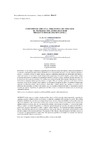Identificador persistente para citar o vincular este elemento:
https://accedacris.ulpgc.es/jspui/handle/10553/71113
| Campo DC | Valor | idioma |
|---|---|---|
| dc.contributor.author | Campos Rodríguez, Clara M. | en_US |
| dc.contributor.author | Santos Peñate, Dolores Rosa | en_US |
| dc.contributor.author | Moreno Pérez,José Andrés | en_US |
| dc.date.accessioned | 2020-03-29T18:00:30Z | - |
| dc.date.available | 2020-03-29T18:00:30Z | - |
| dc.date.issued | 2011 | en_US |
| dc.identifier.issn | 1575-605X | en_US |
| dc.identifier.other | Dialnet | - |
| dc.identifier.uri | https://accedacris.ulpgc.es/handle/10553/71113 | - |
| dc.description.abstract | En este trabajo consideramos un problema de localización donde dos empresas entran secuencialmente en un mercado, compitiendo por captar clientes distribuidos en un conjunto finito de puntos, a los que ofrecen un producto o servicio. La demanda existente se reparte entre las empresas competidoras atendiendo a la proximidad entre clientes y centros proveedores. En este modelo, donde el objeto de la competencia es la cuota de mercado, y donde el único criterio de decisión del cliente es la distancia al suministrador del bien o servicio, la única variable de decisión relevante es la localización de los centros de suministro. Se considera una versión del modelo líder-seguidor. El problema consiste en determinar las estrategias óptimas para dos empresas, la empresa líder y la seguidora, que toman sus decisiones de forma secuencial, con el fin de conseguir ciertos objetivos. La formulación propuesta incorpora un umbral de distancia que representa la diferencia mínima entre la distancia cliente-líder y cliente-seguidor que produce un cambio en la preferencia del consumidor. El objetivo del seguidor, una vez conocida la ubicación del líder, es maximizar la cuota de mercado que captura. El problema de optimización del líder consiste en minimizar la máxima cuota de mercado que capturaría el seguidor. | en_US |
| dc.description.abstract | In this paper we consider a location problem where two firms enter the market sequentially, competing for capturing customers located at a finite set of points, to which the competitors offer a product or service. The existing demand is satisfied by the rival firms according to the proximity between clients and facilities. In this model, where the object of competition is the market share and the only customer decision criterion is the distance from clients to the supplier of goods or services, the only relevant decision variable is the location of facilities. A version of the leaderfollower model is considered. The problem is to determine optimal strategies for each firm, the leader and the follower, which make decisions sequentially in order to achieve certain objectives. The proposed formulation incorporates a distance threshold that represents the minimum difference between the distances client-leader and client-follower that provides a change in the consumer preference. The objective of the follower, when the location of the leader is known, is to maximize its captured demand or market share. The optimization problem of the leader is to minimize the maximum market share that the follower would capture. | en_US |
| dc.language | spa | en_US |
| dc.relation.ispartof | Recta | en_US |
| dc.source | Rect@: Revista Electrónica de Comunicaciones y Trabajos de ASEPUMA[ISSN 1575-605X], n. 12, p. 68-84 | en_US |
| dc.subject | 531102 Gestión financiera | en_US |
| dc.subject | 530301 Contabilidad financiera | en_US |
| dc.subject.other | Cuotas de mercado | en_US |
| dc.subject.other | Programación lineal | en_US |
| dc.subject.other | Líder-seguidor | en_US |
| dc.title | Competencia espacial por cuotas de mercado: el problema del líder-seguidor mediante programación lineal | en_US |
| dc.type | info:eu-repo/semantics/Article | en_US |
| dc.type | Article | en_US |
| dc.identifier.url | http://dialnet.unirioja.es/servlet/articulo?codigo=4215124 | - |
| dc.description.lastpage | 84 | - |
| dc.identifier.issue | 12 | - |
| dc.description.firstpage | 68 | - |
| dc.investigacion | Ciencias Sociales y Jurídicas | en_US |
| dc.type2 | Artículo | en_US |
| dc.contributor.authordialnetid | No ID | - |
| dc.contributor.authordialnetid | 170993 | - |
| dc.contributor.authordialnetid | No ID | - |
| dc.identifier.dialnet | 4215124ARTREV | - |
| dc.utils.revision | Sí | en_US |
| dc.identifier.ulpgc | Sí | es |
| item.fulltext | Con texto completo | - |
| item.grantfulltext | open | - |
| crisitem.author.dept | GIR TIDES- Técnicas estadísticas bayesianas y de decisión en la economía y empresa | - |
| crisitem.author.dept | IU de Turismo y Desarrollo Económico Sostenible | - |
| crisitem.author.dept | Departamento de Métodos Cuantitativos en Economía y Gestión | - |
| crisitem.author.orcid | 0000-0002-2694-7943 | - |
| crisitem.author.parentorg | IU de Turismo y Desarrollo Económico Sostenible | - |
| crisitem.author.fullName | Santos Peñate, Dolores Rosa | - |
| crisitem.author.fullName | Moreno Pérez,José Andrés | - |
| Colección: | Artículos | |
Visitas
264
actualizado el 15-ene-2026
Descargas
66
actualizado el 15-ene-2026
Google ScholarTM
Verifica
Comparte
Exporta metadatos
Los elementos en ULPGC accedaCRIS están protegidos por derechos de autor con todos los derechos reservados, a menos que se indique lo contrario.
